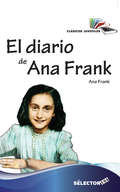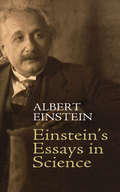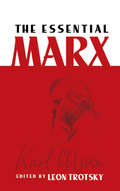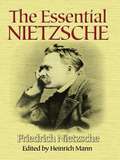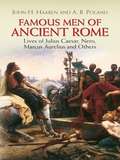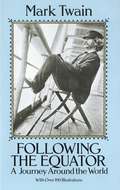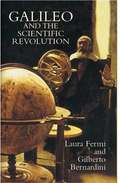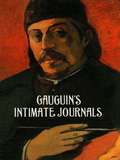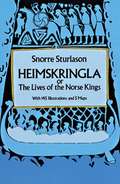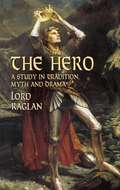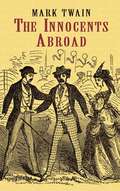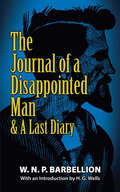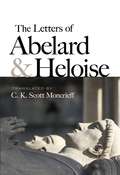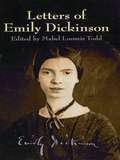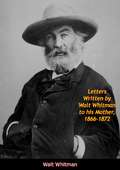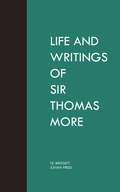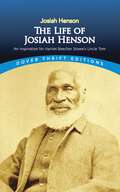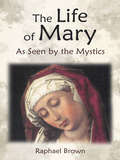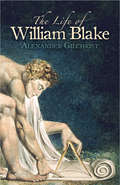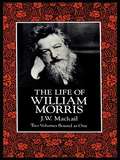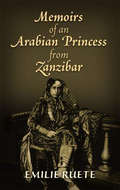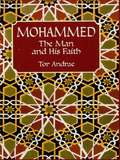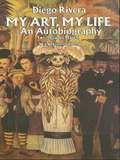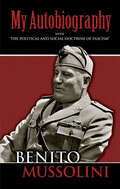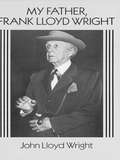- Table View
- List View
El diario de Ana Frank
by Anne FrankDesde su encierro en el Anexo secreto, Ana Frank sueña con convertirse en escritora. Ella nunca lo supo, pero su famoso diario ha dado la vuelta al mundo, ha sido traducido a varios idiomas y se considera uno de los testimonios más genuinos del Holocausto. Por desgracia, Ana Frank murió muy joven y su diario quedó inconcluso, pero entre sus páginas todavía permanecen atrapados sus anhelos juveniles de amor, libertad y trascendencia.
Einstein's Essays in Science
by Albert Einstein Alan HarrisHis name is synonymous with "genius," but these essays by the renowned physicist and scholar are accessible to any reader. In addition to outlining the core of relativity theory in everyday language, Albert Einstein presents fascinating discussions of other scientific fields to which he made significant contributions. The Nobel Laureate also profiles some of history's most influential physicists, upon whose studies his own work was based.Assembled during Einstein's lifetime from his speeches and essays, this book marks the first presentation to the wider world of the scientist's accomplishments in the field of abstract physics. Along with relativity theory, these articles examine the methods of theoretical physics, principles of research, and the concept of scientific truth. Einstein's speeches to audiences at Columbia University and the Prussian Academy of Science appear here, along with his insightful observations on such giants of science as Johannes Kepler, Sir Isaac Newton, James Clerk Maxwell, Niels Bohr, Max Planck, and others.
The Essential Marx: The Communist Manifesto
by Karl Marx Leon TrotskyShortly before he was assassinated in 1940, Leon Trotsky — one of Marx's most devoted converts and a key figure in the Russian Revolution — made this selection from Capital, to which he appended his own lengthy and insightful introduction. Compact and fascinating, this invaluable work not only presents Marx's thoughts in his own words but also places them in the swirling context of the 20th century. A critical analysis of ideas that have influenced millions of lives for well over a century, this book will be an important addition to the libraries of students and instructors of economics, history, government, and Communist thought.
The Essential Nietzsche
by Friedrich Nietzsche Heinrich MannA prominent intellectual of the Weimar era, Heinrich Mann was a leading authority on Nietzsche. This volume consists of Mann's selections of highlights from the philosopher's works, along with an introduction that explains their significance to modern readers.Key excerpts from Nietzsche's books include passages from The Birth of Tragedy, Thoughts Out of Season, The Dawn of the Day, The Joyful Wisdom, Thus Spake Zarathustra, Beyond Good and Evil, The Genealogy of Morals, The Case of Wagner, Nietzsche Contra Wagner, The Twilight of the Idols, The Antichrist, Ecce Homo, and The Will to Power. For ease of reference, Mann has arranged the text in sections corresponding to Nietzsche's views on science, philosophy, and truth; his critiques of culture -- the use and abuse of history, Europeans and Germans, Wagner, the genealogy of morals, and nihilism; his concept of the world without God, including the birth of tragedy out of the spirit of music, the true and the apparent world, and eternal recurrence; and his confessions.
Famous Men of Ancient Rome: Lives of Julius Caesar, Nero, Marcus Aurelius and Others
by John H. Haaren A. B. PolandThis captivating book offers young readers a memorable and meaningful introduction to the famous leaders and great men of ancient Rome. Its biographical sketches are chronologically arranged, from 753 B.C., the estimated founding of Rome, to A. D. 476, the fall of the Western Empire. Readers can compare and contrast the characters of these great men and see how their actions and ideas influenced Rome and the world.The 30 chapters start with the legend of the orphans Romulus and Remus, who were raised by a wolf, and grew up to found the Eternal City. Children also meet a fascinating variety of actual historical figures, including Cincinnatus, who chose to be a farmer instead of a dictator, Nero, the mad emperor, and the warlike Julius Caesar. They'll encounter Marcus Aurelius, the emperor who used his own money to help the poor, and who walked the streets, greeting people and listening to their troubles so that he could be a better leader. Geared toward third- to seventh-graders, Famous Men of Ancient Rome is excellent both for reading aloud and for independent reading and study by students.
Following the Equator: A Journey Around the World
by Mark TwainSo begins this classic piece of travel writing, brimming with Twain's celebrated brand of ironic, tongue-in-cheek humor. Written just before the turn of the century, the book recounts a lecture tour in which he circumnavigated the globe via steamship, including stops at the Hawaiian Islands, Australia, Fiji Islands, New Zealand, India, South Africa and elsewhere.View the world through the eyes of the celebrated author as he describes a rich range of experiences — visiting a leper colony in Hawaii, shark fishing in Australia, tiger hunting, diamond mining in South Africa, and riding the rails in India, an activity Twain enjoyed immensely as suggested by this description of a steep descent in a hand-car: "The road fell sharply down in front of us and went corkscrewing in and out around the crags and precipices, down, down, forever down, suggesting nothing so exactly or so uncomfortably as a crooked toboggan slide with no end to it. . . . I had previously had but one sensation like the shock of that departure, and that was the gaspy shock that took my breath away the first time that I was discharged from the summit of a toboggan slide. But in both instances the sensation was pleasurable — intensely so; it was a sudden and immense exaltation, a mixed ecstasy of deadly fright and unimaginable joy. I believe that this combination makes the perfection of human delight."A wealth of similarly revealing observations enhances this account, along with perceptive descriptions and discussions of people, climate, flora and fauna, indigenous cultures, religion, customs, politics, food, and many other topics. Despite its jocular tone, this book has a serious thread running through it, recording Twain's observations of the mistreatments and miseries of mankind. Enhanced by over 190 illustrations, including 173 photographs, this paperback edition — the only one avai1able — will be welcomed by all admirers of Mark Twain or classic travel books.
Galileo and the Scientific Revolution
by Laura Fermi Gilberto BernardiniAn absorbing account of the origins of modern science as well as a biography of the revolutionary thinker, this inspiring book was co-written by a former director of the Italian Institute for Nuclear Physics and a historian of science (who was also the wife of physicist Enrico Fermi). It begins in Galileo's youth, with his return to his native city of Pisa to train as a physician. Instead, the student became captivated by the power of mathematical reasoning — an interest that led him to apply mathematical logic to natural events and, ultimately, to invent the concept of experimentation. Galileo's progress from student to teacher to scientific innovator is traced, with particular emphasis on his experiments with building and refining telescopes and his unprecedented observations of the moon and planets. The dramatic results of his findings, including his refutation of Aristotelian theory and his support of Copernican doctrine, are related in full, along with his clash with the papal inquisition and his tragic demise under house arrest. Written with a warm appreciation for the wonders of Galileo's achievements and with impeccable scholarship, this book concludes with a survey of the scientist's remarkable legacy. 12 figures. Appendix. Bibliography. Index.
Gauguin's Intimate Journals
by Paul GauguinRevealing documents, reprinted from rare, limited edition, throw much light on the painter's inner life, his tumultuous relationship with van Gogh, evaluations of Degas, Monet, and other artists; hatred of hypocrisy and sham, life in the Marquesas Islands, much more. 27 full-page illustrations by Gauguin. Preface by Emil Gauguin.
Heimskringla: or, The Lives of the Norse Kings
by Snorri SturlusonGreat classic by Icelandic poet/chieftain chronicles the reigns of 16 high kings descended from the warrior-wizard god Odin. Major section on 15-year reign of Olav II Haraldson, patron saint of Norway. Based on earlier histories, oral traditions, plus new material by author, all presented with intelligence, warmth and objectivity. Over 130 illustrations and 5 maps.
The Hero: A Study in Tradition, Myth and Drama (Dover Books On Anthropology, Folklore And Myths)
by Lord RaglanHis mother is a virgin and he's reputed to be the son of a god; he loses favor and is driven from his kingdom to a sorrowful death — sound familiar? In The Hero, Lord Raglan contends that the heroic figures from myth and legend are invested with a common pattern that satisfies the human desire for idealization. Raglan outlines 22 characteristic themes or motifs from the heroic tales and illustrates his theory with events from the lives of characters from Oedipus (21 out of a possible 22 points) to Robin Hood (a modest 13). This new edition of The Hero (which originally appeared some 13 years before Joseph Campbell's The Hero with a Thousand Faces) is assured of a lasting popularity. This book will appeal to scholars of folklore and mythology, history, literature, and general readers as well.
The Innocents Abroad
by Mark TwainHailed by the New York Herald as “an oasis in the desert of works on foreign travel,” The Innocents Abroad was a great success when first published, and it remained the bestselling of all Twain’s works throughout his lifetime. It shows the author at the height of his literary power as he records razor-sharp, often hilarious, observations of the people he meets and places he visits during a trip to Europe and the Holy Land in 1867.Originally a series of travel letters written for a San Francisco newspaper, the book presents a refreshingly honest and vivid view of such places as Tangier, Marseilles, Gibraltar, Rome, Constantinople, and Damascus. Twain’s humor takes a particularly satirical turn toward tourists who rely on travel guidebooks rather than personal impressions to define their travel experiences. The book alternates light-hearted chapters with serious passages involving history, statistics, and descriptions of religious relics, artwork, and architecture.From amusements and tribulations at sea, viewing the “outrageous” cancan in Paris, and witnessing the notable sights of Venice, to observing the grandeur of St. Peter’s, ascending Vesuvius, and contemplating the remains of Solomon’s Temple, this classic will delight a wide audience, including longtime fans of the American humorist and anyone who enjoys an entertaining and enlightening travel book. This edition also includes all the illustrations from the original publication.
The Journal of a Disappointed Man: & A Last Diary
by W.N.P. BarbellionPublished shortly before the author's death in 1919, The Journal of a Disappointed Man presents a remarkable memoir that addresses struggles with poverty, inadequate education, and the creeping paralysis of multiple sclerosis. Yet author W. N. P. Barbellion manages to write with uplifting eloquence and passion of his love for family, natural history, music, and literature. Told with a thoroughly modern voice, the unjustly overlooked Journal is reprinted here with its posthumous successor, A Last Diary. This edition features a thoughtful Introduction by H. G. Wells, who writes of the book's "exquisite beauty." W. N. P. Barbellion (1889–1919), whose real name was Bruce Frederick Cummings, was a naturalist who worked in the Entomology Department of London's Natural History Museum. Upon attempting to enlist in the British Army during World War I, he was diagnosed with multiple sclerosis. The discovery of his disease intensified the tenor of his journal-keeping, and his frank and articulate reflections on coping with a fatal illness remain a powerful testament to his life and struggles.
The Letters of Abelard and Heloise
by C. K. MoncrieffAbelard, a prominent twelfth-century theologian, is hired to tutor Heloise, a brilliant pupil who becomes his lover and the mother of his child. Although the two are secretly married, a misunderstanding leads to Abelard's castration by Heloise's uncle, followed by the lovers' permanent separation. Abelard retreats to a monastery and Heloise to a nunnery — and their subsequent correspondence captured the romantic imaginations of generations of readers. The letters offer insights into the thinking of Abelard, who ranks among the Middle Ages' foremost philosophers, and the spirited determination of Heloise, an early feminist. They have also excited ongoing controversy in terms of their historical content and significance. Translator C. K. Scott Moncrieff takes a modern approach to the correspondence, adding new significance to its reflection of medieval attitudes toward love, marriage, and religion.
Letters of Emily Dickinson
by Emily DickinsonOnly five of Emily Dickinson's poems were published while she lived; today, approximately 1,500 are in print. Dickinson's poetry reflects the power of her contemplative gifts, and her deep sensitivity courses through her correspondence as well. Lovingly compiled by a close friend, this first collection of Dickinson's letters originally appeared in 1894, only eight years after the poet's death. Although she grew reclusive in her later years and seldom saw her many friends, she thought of them often and affectionately, as her missives attest. The small cast of daily characters in Dickinson's little world takes on vivid life in the letters, and her famous wit sparkles from every page.
Life and Writings of Sir Thomas More: Lord Chancellor Of England And Martyr Under Henry Viii
by T. E. BridgettAfter this review of More’s public life and period of prosperity, the reader will be interested to know what was his interior life before God. In addition to what has been said of this by his biographers, especially Roper and Stapleton, as related in previous chapters, we have a picture of a holy statesman drawn by his own pen, in which he has unconsciously described himself; or rather we have an account given of a method of sanctification, which we know from other sources to have been the one so successfully adopted by himself.
The Life of Josiah Henson: An Inspiration for Harriet Beecher Stowe's Uncle Tom (Travel In America Series)
by Josiah HensonBorn into slavery on a Maryland farm, Josiah Henson (1789–1883) worked as a foreman, married, and became a preacher in the Methodist Episcopal Church. Faced with the prospect of separation from his family, Henson fled with his wife and children to Ontario, where he became a leader in the Afro-Canadian community. The Life of Josiah Henson, Formerly a Slave, Now an Inhabitant of Canada, as Narrated by Himself first appeared in 1849. The book's avid readers included Harriet Beecher Stowe, who later acknowledged its influence on her own masterwork, Uncle Tom's Cabin.Henson's narrative recounts the circumstances of his bondage, his conversion to Christianity, and his fruitless attempts to buy his freedom. Risking starvation, exposure, and recapture, the Henson family walked from Kentucky to Ohio. Native Americans assisted the struggling family, as did sympathetic boatmen who ferried them across Lake Erie. Safely established as a tenant farmer and clergyman in a new country, Henson took an active role in organizing a self-sufficient community. His memoirs helped alert his contemporaries to the horrors and heartbreak of slavery, and they offer modern readers an authentic account of one family's triumph over injustice and inhumanity.
The Life of Mary: As Seen by the Mystics
by Anne Catherine Emmerich Raphael Brown Mary Of Agreda James TissotGenerations of devout Catholics, including many learned theologians and writers, have derived great spiritual benefits from a careful reading of the private revelations here compiled, those of Ven. Anne Catherine Emmerich and Ven. Mary of Agreda, primarily, along with those of St. Bridget of Sweden and St. Elizabeth of Schoenau. From the birth of Mary to her Coronation in Heaven, this book provides the reader with remarkable insights into the life of Our Lady, and an unmatched depth of understanding of the Holy Family. What is also shown with utmost clarity is that Mary is a model of the interior life, and an example of perfect submission to the will of God. "As we read," writes Dom Prosper Gueranger, "our heart slowly takes fire, our soul feels desires for virtue which it had not hitherto experienced, the mysteries of faith appear more luminous to us, bit by bit the world and its hopes vanish, and the longing for the good things of Heaven, which seemed to have been dozing within us, awakens with new fervor."
The Life of William Blake
by Alexander GilchristOne of the greatest Victorian-era biographies, Alexander Gilchrist's The Life of William Blake plays a key role in the history of Blake's work and its influence on other writers and artists. The first standard text on Blake and a cornerstone of the extensive scholarship on his life and work, it not only delivered its subject from unjust obscurity but also dispelled the notion of Blake's insanity and established his genius as a visionary artist and poet.Sensitive, highly readable accounts trace Blake's childhood and years as an engraver's apprentice, his relations with patrons and employers, his trial for treason, and his declining health and untimely death. The author's wide-ranging research includes interviews with many of Blake's surviving friends, whose personal recollections add warmth and immediacy to this portrait. Extensive quotes from the subject's poetry and prose — practically unknown at the time of the original 1863 publication — further enliven the text. In addition to a critical commentary on Blake's boyhood poems, this transformative biography features more than 40 of his illustrations.
The Life of William Morris
by J. W. MackailClassic biography of the great Victorian poet, designer and socialist. Published a few years after Morris’ death, it chronicles his childhood, days at Oxford, forays into art and literature, embrace of socialism, involvement with the Arts and Crafts movement, founding of the Kelmscott Press, much more. 22 black-and-white illustrations.
Memoirs of an Arabian Princess from Zanzibar
by Emily Ruete Sayyida Prin. of ZanzibarReturn to an era when Zanzibar was ruled by sultans, and enter a vanished world of harems, slave trading, and court intrigues. In this insider's story, a sultan's daughter who fled her gilded cage offers a compelling look at nineteenth-century Arabic and African royal life. After years of exile in Europe, the former princess wrote this fascinating memoir as a legacy for her children and a warm reminiscence of her island home.Born Salamah bint Said, Princess of Zanzibar, in 1844, author Emily Ruete grew up in a harem with scores of siblings. The royal family maintained its fabulous wealth and luxury with a robust traffic in ivory, spices, and human bondage. Ruete ventures beyond the palace, into the city and plantations where European traders, missionaries, and colonists exercised a growing influence. After her dramatic elopement with a German trader, Ruete attained the perspective to form a comparison of the lives of women in Muslim society with those of their European contemporaries. Originally published in 1886, this remarkable autobiography will captivate readers interested in Zanzibar and Eastern Africa as well as students of Arabic, Islam, and women's studies.
Mohammed: The Man and His Faith
by Tor AndraeLong considered an essential survey of the origins, tenets, and substance of Islam, this biographical classic conveys a deep understanding of the Prophet and his faith. "Even today, after a period of development of thirteen centuries," author Tor Andrae notes, "one may clearly discern in genuine Islamic piety the uniqueness which is ultimately derived from its founder's personal experience of God." Andrae's fascinating profile of Mohammed's life and times encompasses the rich diversity of the Prophet's influence, exploring not only his impact on religion and history but also his political and social relevance.Beginning with an overview of Arabia in the sixth century, Andrae chronicles Mohammed's youth and the circumstances surrounding his prophetic call, offering a cogent analysis of his religious message and doctrine of revelation. The author discusses the conflicts surrounding the Prophet's early preachings that culminated in his flight from Mecca to Medina, where his leadership duties expanded to include the roles of politician, ruler, and military commander. In conclusion, an evaluation of Mohammed's personality offers insights into the everyday conduct that has served as a model to succeeding generations of Muslims.Comprehensive in scope and even-handed in perspective, this is one of the finest volumes available in English about Islam. Mohammed: The Man and His Faith is essential reading for students of religion, and its inspiring examination of Mohammed's deep piety and the power and spiritual energy of his religion will enthrall readers who are well versed in Islam as well as those unfamiliar with the Prophet's life and teachings.
My Art, My Life: An Autobiography
by Diego Rivera Gladys March"Engrossing as a novel … throws a clear white light on one of the most spectacular artists of our time." — Chicago Sunday TribuneThis remarkable autobiography began with a newspaper interview the artist gave journalist Gladys March in 1944. From then until the artist's death in 1957, she spent several months each year with Rivera, eventually filling 2,000 pages with his recollections and interpretations of his art and life. Written in the first person, this book is a richly revealing document of the painter who revolutionized modern mural painting, was a principal figure in launching the "Mexican Renaissance," and is ranked among the most influential artists of the twentieth century.As the colorful narrative unfolds, Diego Rivera seems always to be in the midst of political, artistic, and romantic turmoil. As the reviewer for The New Republic observed, "Rivera reveals a keen appreciation of this prowess in art, sex, and politics, and the record seems to be complete on the series of spectacular rows he got into over all three."The book details his bold confrontations with dictators and presidents, the battles that erupted over his murals in Rockefeller Center and the Hotel del Prado, his tempestuous marriages to Lupe Marin and artist Frida Kahlo, and much, much more. "There is no lack of exciting material. A lover at nine, a cannibal at 18, by his own account, Rivera was prodigiously productive of art and controversy." — San Francisco Chronicle. 21 halftones.
My Autobiography: With "The Political and Social Doctrine of Fascism"
by Benito MussoliniUrged by American Ambassador to Rome Richard Washburn Child to write his autobiography, Benito Mussolini hesitated only slightly before he dictated thoughts on his private and public life. This volume reprints the Italian dictator's extraordinary comments, capturing the spirit and personality of Il Duce as no other book does. Included are Mussolini's views on Italian politics, descriptions of his years as an agitator, journalist, and soldier, the formation of the Fascist Party, the "March on Rome," and his early years in power. The text also contains some of his most famous speeches in the Italian Parliament, his vision of Italy's return to glory, and his definitive statement on the doctrine of Fascism and its political justification.Essential reading for students of history and political science, this frank, and frequently arrogant, revelation of the Italian leader's life produced mixed reactions when first published in 1928. "Like him or not," wrote the reviewer for the Saturday Review of Literature, "here he is, Mussolini the man, the patriot, the leader."
My Father, Frank Lloyd Wright
by John Lloyd Wright"An anecdotal reminiscence of America's chief living genius by his son -- short, unconventional, amusing and on the whole revealing." -- Book Week.Frank Lloyd Wright is widely regarded as the twentieth century's greatest architect -- an unconventional genius who transformed both residential and commercial building design with his concept of "organic" architecture. During a long and productive life, Wright designed some 800 buildings, received scores of honors and awards, and left an indelible imprint on modern architectural theory and practice.In this charming, readable memoir, Wright the architect and father comes to life through the vivid recollections and firsthand knowledge of his son. John Lloyd Wright characterizes his father as "a rebel, a jolt to civilization, whose romantic theme -- purposive planning and organic unity in inventing and combining forms -- is an epoch in the architecture of the world." His unique view of the "epoch" will intrigue architects, students, and all who admire the work of this visionary and uncompromising spirit. An added attraction of this volume is the inclusion of the complete text of William C. Gannet's The House Beautiful, an extremely rare work designed and printed by Frank Lloyd Wright.
